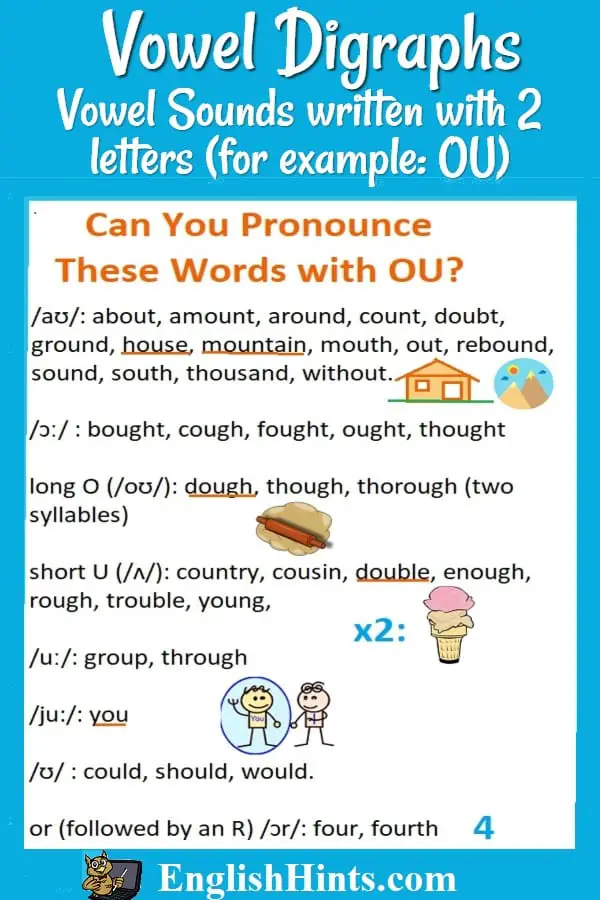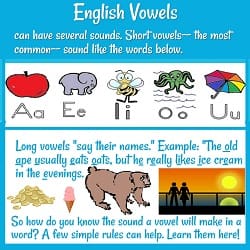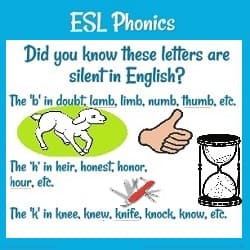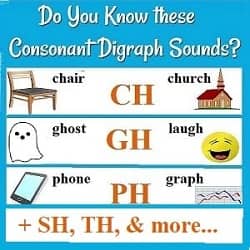How to Pronounce & Spell Vowel Digraphs
Vowel digraphs are vowels written with two letters. Some are a single sound. Others, like ‘au’ or ‘oi,’ are 'diphthongs'. (Diphthongs contain the basic sounds of both vowels, but they glide together.) This page has some suggestions for sounding digraphs out in unfamiliar words.
For Vowels plus 'R' (in words like CAR, CARE, VERY, AWARE, EAR, BIRD, FUR, BETTER, MORE, etc.), see the 'Other Vowel Sounds' section of the English Vowels' page as well as "vowel digraphs with 'R'" below.
Click here to watch a video near the bottom of this page that discusses the ways to pronounce AU, AW, OI, OY, OO, OU, and OW.
Learning how to pronounce and spell English vowel digraphs can also improve your reading.
(Note: These are standard American pronunciations. They may have different pronunciations in some areas.)
Vowel Digraphs Beginning with ‘A’
AI or AY are almost always pronounced as long A -- /eɪ/ in the International Phonetic Alphabet in much of the U.S. (The IPA symbols given here are common pronunciations in the U.S., but they don't apply everywhere! For another exceptions see AIR below the Es.)
- bait, bay, brain, daily, fail, laid, maid, may, paid, pay, praise, raise, say (but NOT said-- it rhymes with red), wait, way.
AU or AW are usually pronounced /ɔː/:
- audio, auditorium, auto, autumn, awful, cause, caught, daughter, raw, saw, taught.
(See the video after OI for this sound plus other digraphs of O and U.)
One common exception is 'because.' At least in my California dialect, we pronounce it with a simple short 'u' sound: be-cuz. (It's the same sound as the 'ou' in cousin.)
Vowel Digraphs Beginning with ‘E’

EA is often pronounced /iː/ like long E (as in the long vowel rule on the English Vowels page):
- beans, cheat, dream, each, easy, heal, lead (the verb), leaf, leave, meat, peas, reach, real, speak, team, treat.
However, EA is also commonly pronounced like a short E (/ɛ/), especially words with 'ead':
- already, bread, breakfast, dead, head, instead, lead (grey substance used in plumbing), measure, ready, spread, weather.
There is no certain way to
predict which pronunciation a word will use.
EE is pronounced with a long E (/iː/ ) :
- bee, deep, feed, feel, free, need, see, seed, steep, tree.
EI is usually pronounced with a long A (/eɪ/):
- eight, neighbor, weigh, OR with a long E (/iː/) after C: deceive, receive.
EU and EW are usually long U (/juː/):
- eulogy, few
or /u:/
- grew, new, stew
AIR, EAR, EER, EIR, and EUR
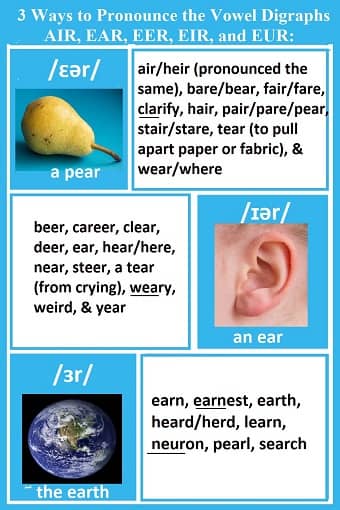
When vowel digraphs are followed by 'R,' their sounds change.
(The exact changes depend on the type-- dialect-- of English. The sounds given below are for general American English.)
AIR, EAR, EER, EIR, & EUR are usually pronounced in one of three ways:
- /ɛər/-- air, chair, flair, pair/pear, their
- /ɪər/-- clear, fear, gear, jeer, peer/pier, sneer, volunteer
- /ɜr/-- early, heard, learn, year
Vowel Digraphs Beginning with ‘I’
IE is usually pronounced with a long E sound (/iː/ ):
- achieve, belief, believe, grieve, piece, relieve. (See EI.)
An old spelling rhyme goes: “I before E except after C, or when pronounced A as in neighbor and weigh.”)
Vowel Combinations Beginning with ‘O’
OA is pronounced with a long O (/oʊ/):
- boast, boat, coat, goal, soap, throat.
OE is also usually pronounced with a long O:
- goes, hoe, poem, toe, woe
but it can also make a /uː/ sound (canoe or shoe)or a short u (/ʌ/) sound (does).
AU or AW, OI or OY, OO (sometimes) and OU or OW (sometimes) can be pronounced with sounds other than the more common short and long vowel sounds.
OU can be especially confusing, as it can be pronounced at least six different ways.
The easiest way to understand them is to watch the video below, which demonstrates how to pronounce them (and the schwa) and gives some examples.
OI and OY make the /ɔɪ/ sound:
- boil, boy, point, soil, toy.
OO is pronounced /uː/ as in:
- food, room, school, soon, too, tool, zoo
or /ʊ/ as in
- book, good, look, stood, took, understood.
OU may be the most difficult digraph to guess.
Its most common sound is /aʊ/:
- about, amount, around, count, doubt, ground, house, mountain, mouth, out, rebound, sound, south, thousand, without.
It can also make the sound of /ɔː/ :
- bought, cough, fought, ought, thought (see AU) ,
long O (/oʊ/):
- dough, though, thorough (two syllables, meaning complete),
short U (/ʌ/):
- country, cousin, double, enough, rough, trouble, young,
long U (/uː/):
- group, through
or (/ju:/):
- you
/ʊ/ :
- could, should, would.
or (followed by an R) /ɔr/:
- four, fourth
OW is pronounced /aʊ/:
- brown, cow, down, how, now, town,
or with a long O (/oʊ/):
- blow, grow, know, low, own, show, throw.
Vowel Digraphs of 'U'
UE is pronounced /uː/:
- blue, true
UI/UY can be pronounced /uː/:
- fruit, suit
or sometimes /ɪ/:
- build
or /aɪ/:
- buy, guy
A good way to learn how these digraphs sound in spoken English is to listen to a speech or podcast with a transcript you can read while you listen. Check out English Listening Practice.
Try Carol Dweck's short TED talk on that page: "The Power of Yet (Believing that you can improve)." She talks about the importance of a growth mindset. That means believing that practicing difficult skills can make you smarter, not prove that you are a failure.
I found 22 vowel digraphs in the first two minutes, or nearly 60 in all. They're almost all mentioned in the list above.
You Might Also Like:
Learn the basic rules to recognize which sounds English vowels will make in different words.
ESL Phonics lists the basic sounds of each letter, with examples.
Learn the different sounds consonant digraphs can make.
They all can help you pronounce what you read-- or spell what you can say.
Didn't find what you
needed? Explain what you want in the search box below.
(For example, cognates, past tense practice, or 'get along with.') Click to see the related pages on EnglishHints.
| site search by freefind | advanced |
